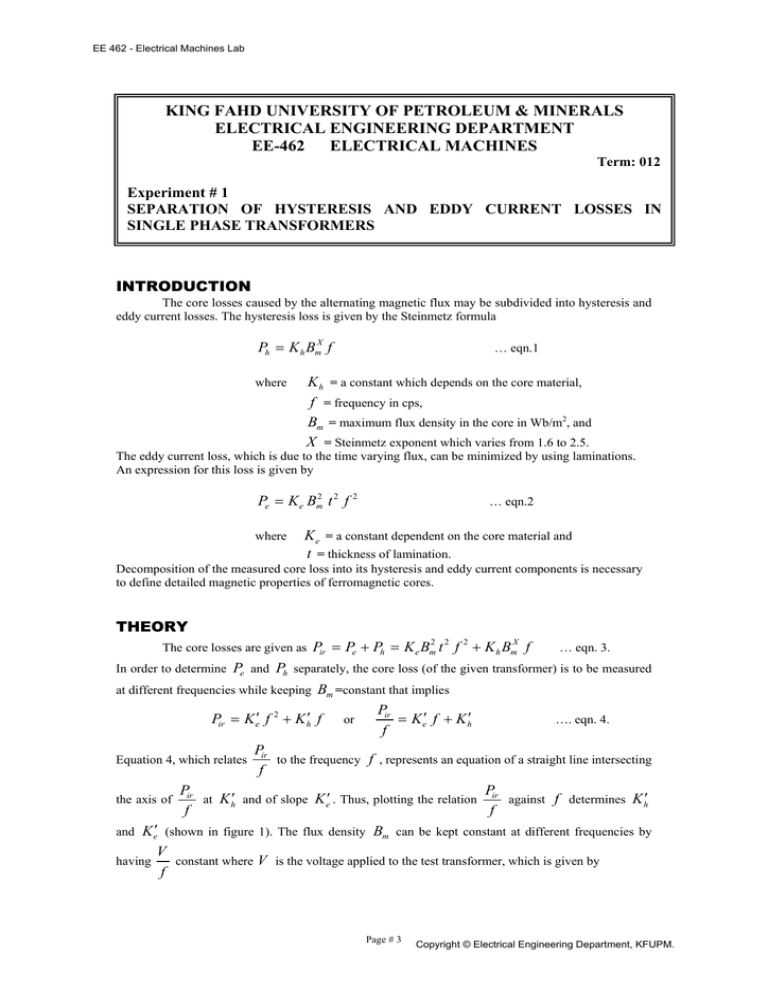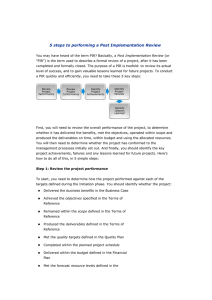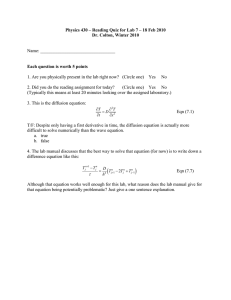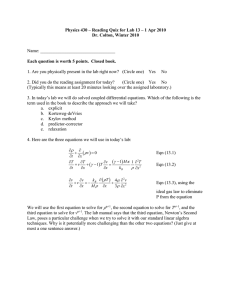EE 462 - Electrical Machines Lab
advertisement

EE 462 - Electrical Machines Lab KING FAHD UNIVERSITY OF PETROLEUM & MINERALS ELECTRICAL ENGINEERING DEPARTMENT EE-462 ELECTRICAL MACHINES Term: 012 Experiment # 1 SEPARATION OF HYSTERESIS AND EDDY CURRENT LOSSES IN SINGLE PHASE TRANSFORMERS INTRODUCTION The core losses caused by the alternating magnetic flux may be subdivided into hysteresis and eddy current losses. The hysteresis loss is given by the Steinmetz formula Ph = K h BmX f where … eqn.1 K h = a constant which depends on the core material, f = frequency in cps, Bm = maximum flux density in the core in Wb/m2, and X = Steinmetz exponent which varies from 1.6 to 2.5. The eddy current loss, which is due to the time varying flux, can be minimized by using laminations. An expression for this loss is given by Pe = K e Bm2 t 2 f 2 where … eqn.2 K e = a constant dependent on the core material and t = thickness of lamination. Decomposition of the measured core loss into its hysteresis and eddy current components is necessary to define detailed magnetic properties of ferromagnetic cores. THEORY The core losses are given as Pir = Pe + Ph = K e Bm2 t 2 f 2 + K h BmX f … eqn. 3. Pe and Ph separately, the core loss (of the given transformer) is to be measured at different frequencies while keeping Bm =constant that implies Pir = K e′ f + K h′ Pir = K e′ f 2 + K h′ f or …. eqn. 4. f P Equation 4, which relates ir to the frequency f , represents an equation of a straight line intersecting f P P the axis of ir at K h′ and of slope K e′ . Thus, plotting the relation ir against f determines K h′ f f and K e′ (shown in figure 1). The flux density Bm can be kept constant at different frequencies by V constant where V is the voltage applied to the test transformer, which is given by having f In order to determine Page # 3 Copyright © Electrical Engineering Department, KFUPM. EE 462 - Electrical Machines Lab V ≅ E = 4.44 fNABm where …. eqn. 5, E = induced emf (rms value), N =the number of turns of the exciting winding, and A = cross-sectional area of the core. V is kept constant, Bm will remain constant. Thus feeding the transformer with different f V Vnom frequencies make it necessary to vary the applied voltage at each frequency so as to have = . f f nom Therefore, if In order to fulfill the above requirements of feeding the transformer, the later is supplied from an alternator whose excitation is kept constant. For such alternator, we have V = kϕ Pn and f = thus P 60 V 60kϕ = = kϕ . If the excitation of the alternator is constant, its output voltage is proportional to f P V the frequency i.e. =constant. f EXPERIMENT 22 OBJECTIVE To measure the core loss at varying frequency and hence separate the hysteresis and eddy current components. 22 PROCEDURE 1. Connect the transformer as for no-load test with its terminals connected to the output terminals of the alternator, which is driven by dc motor (as shown in figure 2). 2. Adjust the field current of the alternator so that it gives an output voltage V and frequency f at rated speed equal to the nominal voltage Vnom and frequency f nom of the transformer and then keep this value of I fg constant all over the test. 3. Vary the speed of the alternator in steps by varying the speed of the driving motor and take readings of W0 , A0 , V0 , and f for each value of the speed. 4. Measure the transformer primary dc resistance r1 by the volt-ampere method. 5. Calculate Pir for each speed from P0 = I 02 r1 + Pir 6. Plot a curve of …eqn.6. Pir against f and then obtain the eddy and hysteresis losses at the rated f voltage and frequency. 7. Repeat the above steps for a value of V equal half the value chosen in step#2. f 8. Calculate the exponent X of equation 1: Ph = K h Bm f . We have B = Bnom at X and B = 0.5 Bnom at V Vnom = f f nom V V = 0.5 nom . If Ph1 corresponds to Bnom and Ph 2 corresponds to f f nom Page # 4 Copyright © Electrical Engineering Department, KFUPM. EE 462 - Electrical Machines Lab 0.5.Bnom X P Ph1 K h f Bnom at rated frequency, then, = or ln h1 = X ln 2 , hence, X X Ph 2 Ph 2 K h f 0.5 Bnom Ph1 Ph 2 X = ln 2 ln … eqn.7. Equation 7 determines the Steinmetz exponent for the test core material. Pir f tan α = K e′ α ↑ K h′ ↓ → f Figure 1. Plot of Pir versus f f W0 M DC Supply A G f A0 V0 Ifg Test Transformer Figure 2. Experimental setup Page # 5 Copyright © Electrical Engineering Department, KFUPM.



